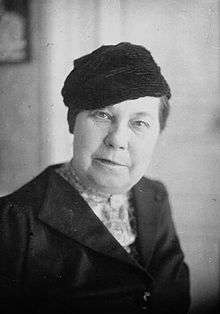Camille Marbo
Marguerite Borel known as Camille Marbo (11 April 1883 – 5 February 1969) née Marguerite Appell, was a 20th-century French writer, president and laureate of the Prix Femina in 1913 and president of the Société des gens de lettres.
Camille Marbo | |
|---|---|
 Camille Marbo en 1937, photo Agence de presse Meurisse. | |
| Born | Marguerite Appell 11 April 1883 |
| Died | 5 February 1969 (aged 85) |
Biography
Daughter of mathematician, Paul Appell (1855–1930), Camille Marbo was given the name Marguerite Appell.
In 1901, she married the mathematician and politician Émile Borel (1871–1956).

In 1906, she created La Revue du mois, a scientific and literary journal, with her husband. The publication allowed contributors the opportunity to choose and discuss subjects as they pleased. Marguerite Borel personally took charge of the critiques of plays, novels, and various chronicles.
When she began writing novels, she chose the pseudonym Camille Marbo, the name Marbo taking the first three letters of her first name Marguerite and the first two of her last name Borel.
In 1913, Camille Marbo was awarded the Prix Femina, then called Prix de la Vie heureuse, for her first novel La statue voilée.
During the First World War, she set the Comité de secours national, the national relief committee with her father. She also founded and ran a temporary hospital in Paris, which earned her the Medal of French Gratitude.[1] In 1916, she was asked to participate in the organization of women in the workforce in place of the men who had gone to battle. Benefiting from her experience as head of the hospital, she created a recruitment center for women, which auditioned, tested, and employed both salaried employees and volunteers in the services sector.[2] More than 20,000 women were employed through this program. The treatise she published in 1919, "Mobilization féminine en France", documents the contribution of these women to the Allied victory.[3] This document is notable for its unique content as well as its methodical and professional form. It is carefully contextualized and enriched with statistics.[4]
She wrote about forty other novels, some monographs and memoirs.
A friend of Marie Curie, she welcomed Marie and her daughters into her home and gave them shelter during the "affaire Langevin", a revelation made by the press of an extramarital affair between Marie Curie, a widow at the time, and Paul Langevin.[5]
Marguerite Borel took part in the political life of Saint-Affrique and participated in the electoral campaigns of her husband, Émile Borel. Marguerite herself was deputy mayor of Saint-Affrique from 1947 to 1954.
In February 1928, Camille Marbo succeeded Mme Jean Dornis as president of the Denier des veuves de la SGDL, giving assistance to the widows of writers without resources.
She became president of the Société des gens de lettres in 1937 and was re-elected in 1938 and again after the liberation in 1947. She was also a member of the jury of the Prix Femina and later became its president.
She published her memoirs in 1967 under the title À travers deux siècles, souvenirs et rencontres (1883-1967).
Marguerite died in 1969, she was a Commander of the Legion Of Honour.
Works
.jpg)
- 1906: Christine Rodis
- 1913: La Statue voilée, (Prix Femina in 1913)
- 1918: Le Survivant
- 1924: Les Cahiers de Francine
- 1925: À l'enseigne du Griffon
- 1926: Hélène Barraux (celle qui défiait l'amour)
- 1931: À bord de la "Croix du Sud"
- 1932: Celle qui défiait l'amour
- 1933: Ruth
- 1934: Le Perroquet bleu
- 1936: Flammes juives
- 1938: Les Millions de l'émir
- 1941: Le Créole au cœur ardent
- 1941: Violette et son cœur
- 1943: La Baie des courlis
- 1944: L'Oiseau captif
- 1945: Le Buisson de lilas
- 1945: La Nièce du boucanier
- 1946: La Maison Bartholène
- 1947: L'Enigme du manoir
- 1947: Tante Estelle
- 1948: L'Idole offensée
- 1949: Sous les eucalyptus
- 1949: Le Chateau condamné
- 1950: La Tour carrée
- 1951: La Reine de Golconde
- 1952: Monsieur Charles
- 1953: Douce marraine
- 1953: Jeux de la science et de l'amour
- 1955: Isabelle et le secret
- 1955: Le Visiteur inconnu
- 1956: L'Amie de pension
- 1957: Le Bel héritage
- 1958: Mademoiselle Anaïs
- 1959: La Dame de Maison-Blanche
- 1959: Les Lettres
- 1960: Le Diamant bleu
- 1961: La Dernière nuit
- 1961: Un Étrange garçon
- 1962: Le Fiancé mystérieux
- 1963: La Protectrice
- 1964: Les Amoureux du Castillou
- 1965: L'Énigmatique Sylvio
- 1965: Le Sel de ma vie
- 1966: Mon amour, d'où viens-tu ?
- 1967: À travers deux siècles, souvenirs et rencontres (1883–1967), Paris, Grasset
- 1967: Clara Fontaine
Distinctions
- Commander of the Legion Of Honour.
- Prix Femina, then called Prix de la Vie heureuse, 1913.
- Medal of French Gratitude.
References
- (Ross 2009, p. 72).
- (Ross 2009, pp. 72–73).
- (Ross 2009, p. 73).
- (Ross 2009, pp. 73–75).
- "Marie Curie and The Science of Radioactivity". history.aip.org. Retrieved 2019-06-12.
Bibliography
- "Camille Marbo", in Nouveau Dictionnaire national des contemporains, Paris, 1962, vol. 1, p. 579.
- Mary Ellen Ross (2009). "Marguerite Borel/ Camille Marbo: The Government's feminist". French and francophone women facing war (in French). Berne: Peter Lang. pp. 69–84. ISBN 3039113321. Ross2009. Read online.
- Mémoires : À travers deux siècles, souvenirs et rencontres (1883–1967), Paris, Éditions Grasset, 1967.
External links
- Camille Marbo on the site of the Académie française
- Biographie
- Notice on Tombes et sépultures
- Jeux de la science et de l'amour première partie on Revue des Deux Mondes